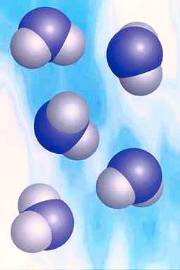8 September 1998
Bug Free Quantum Computing

Quantum computing promises processing power far in excess of even the most advanced computers available today. Complex simulations and large number factoring are just two of the applications that choke conventional computers, but would be solved in a trice by quantum computers.
One of the major stumbling blocks in implementing a succesful 'machine' to date has been the lack of reliable error checking. But in yesterday's issue of Physical Review Letters, researchers reported on the first experimental use of quantum error correction in a three-bit quantum computing system. Working with David Cory at the Massachusetts Institute of Technology, Los Alamos National Laboratory researchers Raymond Laflamme, Wojciech Zurek and Emanuel Knill are using nuclear magnetic resonance, or NMR, to test their theories.
"We have demonstrated for the first time that our quantum error correction works as expected. It is also the first time anyone has manipulated three bits in a quantum mechanical way," said Los Alamos physicist Raymond Laflamme.
Unlike today's "classical" computers that make calculations with a binary system of zeroes and ones from digital switches, first-generation quantum computers are assembled from molecular switches called qubits. A qubit can represent one, zero or potentially any state in between.
A functional quantum computer will manipulate atoms to perform many calculations at once by taking advantage of quantum mechanics, which allows qubits to represent many states simultaneously. "Suddenly you have information encoded on single atoms and you can do things that you never thought you would be able to do before. The rules change and you are not working with the classical rules but the quantum mechanical rules now," said Laflamme.
Until recently, the main problem for quantum computing was believed to be an inability to correct errors. Two years ago, the Los Alamos team developed a scheme that uses repetitive processing to reduce the probability of errors. For the general error type, every encoded qubit is checked for errors, corrected, then multiplied five times. Those five qubits also get checked for errors then corrected and multiplied, and so on. Knowing how many steps a particular calculation takes, the theorists can determine the number of checks needed to ensure the calculation's accuracy.
Now the physicists have adopted NMR techniques, which are widely used to study the structure of molecules and to measure magnetic fields, for experimenting with qubits. NMR allows scientists to manipulate the atomic spins of nuclei by applying an electromagnetic pulse to molecules diluted in a liquid. Sending a pulse for a specific amount of time generates a known signal. The signal is amplified by the molecules acting in parallel. Because the researchers knew the most common errors in NMR were of a specific type, they could test quantum error correction ideas using only a three-qubit system.
Laflamme admits a functional quantum computer that can exceed the capabilities of current machines is years away. However, these experiments show the hurdles to be overcome are not mathematical but only mechanical - the considerable difficulty of manipulating individual atoms.
